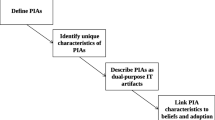Abstract
This paper considers the concept of agency and the applications of software agents within the field of Personal Information Management (PIM). PIM addresses the complex activities undertaken by individuals when organising their personal information. In the context of Personal Information Management, effective software agents may allow users to obtain information relevant to their tasks, and present it in a form that is directly targeted to the needs of the user.
This paper concentrates on the notion of agency and its direct application to PIM tasks. A user-driven approach to the design of agent-based systems is presented. We argue that agent systems will only be successful if both usersand their tasks act as the bases for the design of such systems. An example task domain (searching the World-Wide Web) is introduced and a taxonomy of Web agents for the domain is discussed. Technical issues raised during the preliminary implementation of Web agents are also introduced.
Similar content being viewed by others
References
Thomas PJ, Macredie RD, Meech JF. (1994) Information Management using Integrated Personal Information Appliances. In: Proceedings of the BCS Computer Graphics and Displays Group Conference on Digital Media and Electronic Publishing.
Malone T, Grant K, Lai K-Y, Rao R Rosenblitt D. (1989) The Information Lens: An Intelligent System for Information Sharing and Coordination. In: Olson N. (ed.) Technological Support for Work Group Collaboration (Lawrence Erlbaum Associates.)
Lai K-Y, Malone T, Yu K-C (1988) Object Lens: A “Spreadsheet” for Cooperative Work. ACM Communications on Office Information Systems, 6(4): 332–353.
Malone T, Lai K-Y (1992) Experiments with Oval: A Radically Tailorable Tool for Cooperative Work. In: Proceedings of CSCW'92 (ACM): 289–297
Maes P (1994) Agents that Reduce Work and Information Overload. Communications of the ACM, 37(7): 31–40.
Etzioni O and Weld D. (1994) A Softbot-Based Interface to the Internet. Communications of the ACM, 37(7): 72–76.
Jennings NR, Wooldridge MJ. (1997) Software Agents. IEE Review, January: 17–20.
Wooldridge MJ, Jennings NR (1995) Intelligent Agents: Theory and Practice. Knowledge Engineering Review, 10(2): 115–152.
Bates J (1994) The Role of Emotion in Believable Agents. Communications of the ACM, 37(7): 122–125.
Minsky M (1994) A Conversation with Marvin Minsky about Agents. Communications of the ACM, 37(7): 23–29.
Kay A User Interface — A Personal View. In: Laurel B (ed.) The Art of Human — Computer Interface Design (Addison-Wesley, Inc): 191–207.
Negroponte N Hospital Corners. In: Laurel B (ed.) The Art of Human — Computer Interface Design (Addison-Wesley, Inc): 347–353.
Laurel B. (1990) Interface Agents: Metaphors with Character. In: Laurel B. (ed.) The Art of Human —Computer Interface Design (Addison-Wesley, Inc): 355–365.
Norman, D A. (1994) How Might People Interact with Agents. Communications of the ACM, 37(7): 68–71.
Norman DA, Draper S. (eds.) (1986) User Centered System Design (Hillsdale, N.J.: Lawrence Erlbaum).
Lanier J. (1996) Agents of Alienation. Hotwired (http:// www.voyagerco.com/misc/jaron.html).
Shoham Y. (1993) Agent-Oriented Programming. Artificial Intelligence, 60: 51–92.
Mitchell T, Caruana R, Freitag D, McDermott J, Zabowskil D. (1994) Experience With a Learning Assistant. communications of the ACM, 37(7): 81–91.
Riecken D. (1994) An Architecture of Integrated Agents. Communications of the ACM, 37(7): 107–116.
Kass R, Finin T. General User Modelling: A Facility to Support Intelligent Interaction. In: Sullivan J W, Tyler S W. (eds.) Intelligent User Interfaces (ACM Press).
Selker, T. (1994) Coach: A Teaching Agent That Learns. Communications of the ACM, 37(7): 92–99.
Berners-Lee T, Cailliau R, Luotonen A, Nielsen H F, Secret A. (1994) The World-Wide Web. Communications of the ACM, 37(8): 76–82.
Nielsen H F. The World Wide Web Consortium Library of Common Code (W3C LCC). World Wide Web Consortium.
Author information
Authors and Affiliations
Corresponding authors
Rights and permissions
About this article
Cite this article
Macredie, R.D., Keeble, R.J. Software agents and agency: A personal information management perspective. Personal Technologies 1, 88–100 (1997). https://doi.org/10.1007/BF02199214
Issue Date:
DOI: https://doi.org/10.1007/BF02199214




